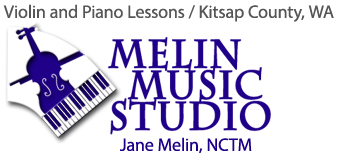Since most parents looking for a private violin teacher ask this question sooner or later, I usually begin by stating, “I’m not a Suzuki teacher.” My teaching approach prioritizes music literacy, musical variety, and unlimited learning. Major influences besides my own private teachers have been teacher training with Mimi Zweig (a blend of the Suzuki Method with Paul Rolland and other influences) and Mark O’Connor (non-classical music from the Americas), with study of reference works by master teachers Ivan Galamian, Simon Fischer and others. My standard study progression for beginners through early-intermediate uses a variety of method and repertoire books. After Level 4 (equivalent to early Suzuki Book 4), instruction becomes even more individualized.
I teach students how to read music from the very beginning, unlike the traditional Suzuki Method. I use method books like All for Strings or The Doflein Method to teach music-reading, and add solo pieces from other sources. To develop an ear for good tone and playing-in-tune, I like to use teaching materials with engaging playalong recordings. The “Fiddle Time” series, published by Oxford University, is one of my favorites for younger students.
Each technical level consists of specific teaching materials in these categories:
| Method | Music-reading skills, short teaching tunes |
| Technique | Exercises for training the muscles in the physical setup and motions for playing the violin |
| Scales | Combines music-reading skills with technique to learn foundational building blocks of music composition |
| Theory | Applied music-reading information and written exercises |
| Repertoire | Longer musical pieces in which the knowledge gained in the other 4 categories is applied, along with expression and interpretation |
Most young piano students use a coordinated book series with one book for each component from the same publisher. But there are no published violin materials that integrate all these components from the same source. So I have selected a combination of materials based on student age and prior experience to be used for teaching at each level. Each weekly lesson assignment will normally include something from every category.
The piano is the single-best musical instrument for teaching music theory, in my opinion! I encourage all my strings students to have one lesson a year at which they sit down at the keyboard to review intervals, scales and arpeggios/chords, the Circle of Fifths, and how scales translate to key signatures.
Here are the titles of the books used through Level 4, also listed on the Bookstore page for purchase links:
A Tune A Day Beginning Scales (Violin)
All for Strings Violin Book 1, Book 2, Book 3
All for Strings Theory Workbook for Violin – Book 1, Book 2
Essential Elements for Violin – Book 1, Book 2
Essentials for Strings (Scales) – Violin
First Solos from the Classics
Fiddle Magic
Fiddle Time Joggers, Runners and Sprinters (Books 1, 2 and 3)
Fiddle Time Scales – Violin – Book 1, Book 2
Introducing the Positions – Violin – Book 1
Mark O’Connor Violin Method – Book 1-Book 3
Solos for Young Violinists – Book 1-Book 3
Spotlight on Strings – Violin – Book 1, Book 2
Suzuki Violin School Book 1–Book 4
The Doflein Method – Violin – Book 1, Book 2
Theory for Everyone – Violin – Book 1, Book 2
Wohlfahrt Foundation Studies for the Violin (Rachel Barton Pine ed.) – Book 1, Book 2
